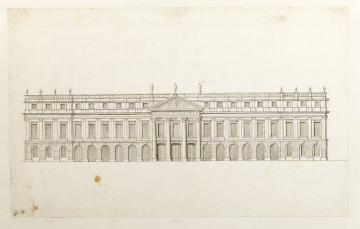Scale
20 feet to 1 inch
Inscribed
In ink by Hawksmoor beneath central pediment, GVLIELMVS. ET. MARIA. R. ET. R. F. ; and by George Dance at bottom left, Gd, and to right in C19 hand, (8)
Signed and dated
- Undated, but datable March 1689
Medium and dimensions
Pen and brown ink over graphite under drawing and vertical incised lines marking bay divisions; on laid paper, laid down; 232 x 374
Hand
Hawksmoor
Watermark
IHS CDG
Notes
This elevation relates closely to the preliminary plan (1, above; 110/4): its length of 260 feet and its projecting central and end pavilions correspond to the Privy Garden front on that plan. It also corresponds to a plan of the Privy Court at first-floor level at All Souls (Geraghty 2007, No. 208; AS, I.10), in which access to the main floor apartments is via a grand staircase of 44 steps in the north-west corner of the quadrangle, rather than from external steps on the north side of the Great Hall. This arrangement was directly linked to a new layout of the King and Queen’s apartments, which now meet at the south-east corner, as in the executed building, rather than in the centre of the east front, as in the first scheme. This would indicate a main floor level about 21 feet above ground level. In this design the principal floor level is 18 feet above ground level; this is consistent with a staircase of 44 steps with risers at a modest 5 inches. The elevational design differs from that implied by the first-floor plan at All Souls plan in one important respect and may be a development upon it. While on both designs the end pavilions are 40 feet wide and the central pavilion is 42 feet wide and three windows, here the central pavilion has an applied giant order resting on the ground. Wren and Hawksmoor have based the elevation on the garden front of Versailles, as engraved by Antoine Perelle in about 1685. The four-columned applied giant portico was a common device in Wren’s repetoire and derived from John Webb’s King Charles II Building at Greenwich.
Literature
Wren Society, IV, pl.15 (top); Fürst, 1956, fig.95; Thurley, 2003, p.153, fig.130
Level
Drawing
Digitisation of the Drawings Collection has been made possible through the generosity of the Leon Levy Foundation
Sir John Soane's collection includes some 30,000 architectural,
design and topographical drawings which is a very important resource for
scholars worldwide. His was the first architect’s collection to attempt to
preserve the best in design for the architectural profession in the future, and
it did so by assembling as exemplars surviving drawings by great Renaissance
masters and by the leading architects in Britain in the 17th and 18th centuries
and his near contemporaries such as Sir William Chambers, Robert Adam and
George Dance the Younger. These drawings sit side by side with 9,000 drawings
in Soane’s own hand or those of the pupils in his office, covering his early
work as a student, his time in Italy and the drawings produced in the course of
his architectural practice from 1780 until the 1830s.
Browse (via the vertical menu to the left) and search results for Drawings include a mixture of
Concise catalogue records – drawn from an outline list of the collection – and
fuller records where drawings have been catalogued in more detail (an ongoing
process).


